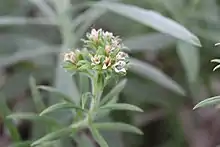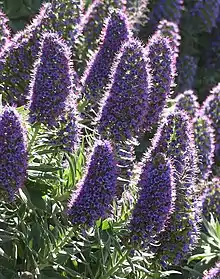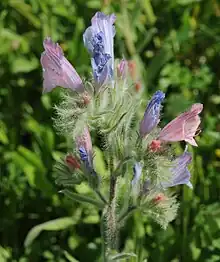Echium
Echium /ˈɛkiəm/[1] is a genus of flowering plants in the family Boraginaceae that contains about 70 species and several subspecies.
| Echium | |
|---|---|
 | |
| Echium vulgare | |
| Scientific classification | |
| Kingdom: | Plantae |
| Clade: | Tracheophytes |
| Clade: | Angiosperms |
| Clade: | Eudicots |
| Clade: | Asterids |
| Order: | Boraginales |
| Family: | Boraginaceae |
| Subfamily: | Boraginoideae |
| Genus: | Echium L. |
| Type species | |
| Echium vulgare | |
| Species | |
|
See text | |


Species of Echium are native to North Africa, mainland Europe to Central Asia, and the Macaronesian islands where the genus reaches its maximum diversity. Twenty-nine species of Echium are endemic to the Canary, Madeira, and Cape Verde archipelagos.[2] The continental species are herbaceous, whereas many of the endemic species of the Macaronesian islands are woody perennial shrubs.[3]
Etymology
The Latin genus name Echium comes from the Greek ἔχιον echion, referring to Echium plantagineum[4] and itself deriving from ἔχις echis (viper); the Greek term dates to Dioscorides, who noted a resemblance between the shape of the nutlets and a viper's head.[5] The genus Echium was published by Carl Linnaeus in 1753.
Cultivation and uses
Many species are used as ornamental and garden plants and may be found in suitable climates throughout the world.[6] In Crete, Echium italicum is called pateroi (πάτεροι) or voidoglosses (βοϊδόγλωσσες) and its tender shoots are eaten boiled or steamed.[7]
Echium species are used as food plants by the larvae of some Lepidoptera species including Coleophora onosmella and orange swift.
In some countries Echium extract has been used as cure for various diseases and is believed to have beneficial properties.
Echium seed oil
The seed oil from E. plantagineum contains high levels of alpha-linolenic acid (ALA), gamma-linolenic acid, and stearidonic acid, making it valuable in cosmetic and skin-care applications, with further potential as a functional food, as an alternative to fish oils.[8] However, despite its high ALA content, Echium seed oil does not increase docosahexaenoic acid and eicosapentaenoic acid levels.[9]
Invasiveness
Some species have been widely naturalized in Mediterranean climates, including South Africa, Australia, New Zealand, and parts of South America and the United States.[10] For example, Echium plantagineum has become a major invasive species in Australia.
Species
- Echium acanthocarpum Svent.
- Echium aculeatum Poir.
- Echium albicans Lag. & Rodr.
- Echium amoenum Fisch. & C.A.Mey
- Echium anchusoides Bacch., Brullo & Selvi
- Echium angustifolium Lam.
- Echium arenarium Guss.
- Echium asperrimum Lam.
- Echium auberianum Webb & Berthel.
- Echium bethencourtii Santos.
- Echium biebersteinii Lacaita.
- Echium boissieri Steud.
- Echium bonnetii Coincy.
- Echium brevirame Sprague & Hutch.
- Echium callithyrsum Webb ex Bolle.
- Echium candicans L.f.
- Echium canum Emb. & Maire
- Echium clandestinum Pomel
- Echium creticum L.
- Echium decaisnei Webb & Berthel.
- Echium flavum Desf.
- Echium gaditanum Boiss.
- Echium giganteum L.f.
- Echium glomeratum Poir.
- Echium handiense Svent.
- Echium hierrense Webb ex Bolle
- Echium horridum Batt.
- Echium humile Desf.
- Echium hypertropicum Webb.
- Echium italicum L.
- Echium judaeum Lacaita.
- Echium khuzistanicum Mozaff.
- Echium × lemsii G.Kunkel.
- Echium leucophaeum Webb ex Sprague & Hutch.
- Echium × lidii G.Kunkel
- Echium longifolium Delile.
- Echium lusitanicum L.
- Echium modestum Ball.
- Echium nervosum W.T. Aiton
- Echium onosmifolium Webb & Berthel.
- Echium orientale L.
- Echium pabotii Mouterde.
- Echium parviflorum Moench
- Echium perezii Sprague
- Echium petiolatum Barratte & Coincy.
- Echium pininana Webb et Berthel.
- Echium pitardii A.Chev.
- Echium plantagineum L.
- Echium portosanctense J.A.Carvalho, Pontes, Bat.-Marques & R.Jardim
- Echium rauwolfii Delile.
- Echium rosulatum Lange
- Echium rubrum Forssk.
- Echium sabulicola Pomel.
- Echium salmanticum Lag.
- Echium simplex DC.
- Echium spurium Lojac.
- Echium stenosiphon Webb.
- Echium strictum L.f.
- Echium suffruticosum Barratte.
- Echium sventenii Bramwell.
- Echium x taibiquense P.Wolff & Rosinski.
- Echium tenue Roth.
- Echium thyrsiflorum Masson ex Link.
- Echium triste Svent.
- Echium trygorrhizum Pomel.
- Echium tuberculatum Hoffmanns. & Link.
- Echium velutinum Coincy.
- Echium virescens DC.
- Echium vulcanorum A.Chev.
- Echium vulgare L.
- Echium webbii Coincy.
- Echium wildpretii Pears. ex Hook. fil.
References
- Sunset Western Garden Book, 1995:606–607
- https://repositorio.ul.pt/bitstream/10451/41473/1/ulfc125744_tm_Ricardo_Costa.pdf
- Böhle, U.-R., Hilger, H.H. & Martin, W.F. 2001. Island colonization and evolution of the insular woody habit in Echium L. (Boraginaceae). Proceedings of the National Academy of Sciences 93:11740-11745.
- ἔχιον. Liddell, Henry George; Scott, Robert; A Greek–English Lexicon at the Perseus Project.
- Pusateri, W. P. and Blackwell, W. H., Jr. 1979. The Echium vulgare complex in eastern North America. Castanea 44: 223–229
- "Echium Tourn. ex L." Plants of the World Online. Royal Botanic Gardens, Kew. Retrieved 11 April 2023.
- Kleonikos G. Stavridakis , Κλεόνικος Γ. Σταυριδάκης (2006). Wild edible plants of Crete - Η Άγρια βρώσιμη χλωρίδα της Κρήτης. Rethymnon Crete. ISBN 960-631-179-1.
- National Non-Food Crops Centre. "NNFCC Crop Factsheet: Echium". nlaf.uk. Retrieved 2 January 2023.
- Lane KE, Wilson M, Hellon TG, Davies IG. (2022). "Bioavailability and conversion of plant based sources of omega-3 fatty acids – a scoping review to update supplementation options for vegetarians and vegans". Critical Reviews in Food Science and Nutrition. 62 (18): 4982–4997. doi:10.1080/10408398.2021.1880364. PMID 33576691. S2CID 231899843.
{{cite journal}}: CS1 maint: multiple names: authors list (link) - "Echium plantagineum Risk". California Invasive Plant Council. 15 October 2017.



